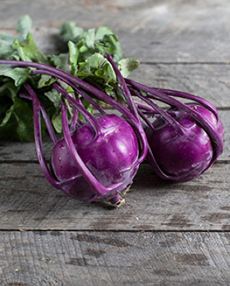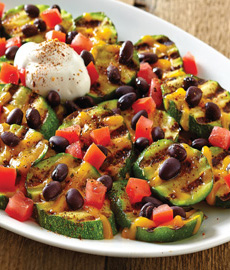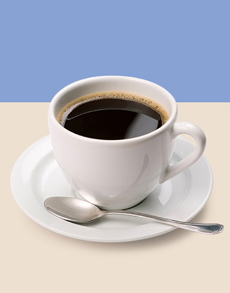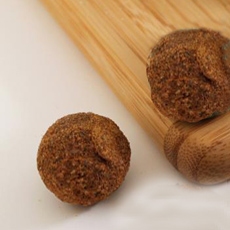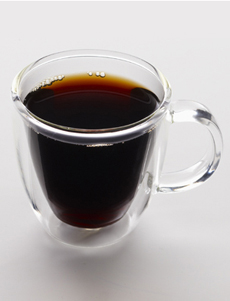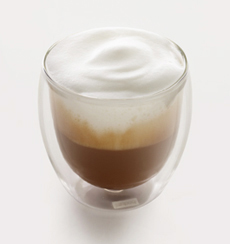
Three stems of curly kale with one of red
Russian kale. Photo courtesy
NationalKaleDay.org. |
|
Yesterday we focused on kale’s cousin, kohlrabi. But today is National Kale Day. If you’re one of the few better-eating-oriented food enthusiasts who hasn’t yet tried kale, today’s the day.
This is the second annual National Kale Day, established as the first Wednesday in October. The holiday was established by Drew Ramsey, M.D. and chef Jennifer Iserloh, authors of 50 Shades of Kale.
Their objective was to draw attention to the superfood, which continues to grow in popularity in both the retail and foodservice (restaurants, schools and other institutions, etc.) markets.
The kale trend has driven up sales 20%-30% in the last year alone. As an illustration of how popular kale has become, mainstream producer Dole Fresh Vegetables recently rolled out new six salad mixes, all with kale, including a Kale Caesar salad kit.
Kale is grown around the world, and has been cultivated for some 6,000 years. It’s easy to grow and hearty: A kale plant continues to produce late into winter, and after a frost, kale becomes even sweeter.
TYPES OF KALE
If you’re already a fan of green kale, visit farmers markets for specialty varieties. There are more than 50 varieties of kale, but in the U.S. you’re most likely to find:
|
|
Curly kale, the variety typically found in grocery stores. It can be bright green, dark green or purple in color with tight ruffled leaves. The fibrous stalks can be difficult to chop, but they’re easy to tear if fresh. The flavor is pungent, peppery and bitter. Seek out younger looking leaves for less bitterness.
Lacinato kale, also called black kale, dinosaur kale, Tuscan kale and other names*. It’s an Italian heirloom with blue-green leaves. Slightly sweeter and more delicate in flavor than curly kale, it has nutty, earthy notes.
Redbor kale, best known as ornamental kale, dark red or purple in color. It is certainly edible. You can grow it as a garden decoration and pick leaves as you need them, for cooking or garnishing.
Red Russian kale with flat leaves that resemble arugula leaves. It gets its name because the stems can have a red or reddish-purple tinge. It is considered one of the more flavorful kales, sweet and mild with just a bit of pepperiness. The stems, however, are too tough to digest and should be removed before cooking.
*Lacinto kale is also called black kale, black Tuscan palm, cavolo nero (which means black cabbage in Italian), dinosaur kale, flat back cabbage, Italian kale, palm tree kale, Tuscan cabbage and Tuscan kale.
|
|
To celebrate National Kale Day, make your favorite kale dish. Have you ever tried colcannon, a traditional Irish dish of kale (or cabbage) and mashed potatoes? We’re making it for dinner tonight, along with this kale salad:
RECIPE: SHREDDED KALE WITH DATE PURÉE & PINE NUTS
This recipe is from Svitana of ArtDeFete.com. She enhances a conventional vinaigrette with date purée for an exciting new flavor combination.
Ingredients For 4 Servings
For The Date Purée
2 cups Medjool dates, pitted
2 cups water
½ teaspoon sea salt
Pinch nutmeg
Pinch cayenne pepper
½ lemon, juiced
|
|

Shredded kale salad with date purée. Photo courtesy ArtDeFete.com.
|
For The Salad
1 bunch kale, center ribs removed, leaves finely shredded
¼ cup pine nuts, toasted
Optional garnish: ¼ cup Panko bread crumbs, toasted
For the Dressing
1½ tablespoons red wine vinegar
2 tablespoons extra-virgin olive oil
1 tablespoon date purée
Salt and freshly ground black pepper
Preparation
1. MAKE the date purée: In a food processor, combine dates, water, salt, nutmeg, cayenne and lemon juice. Blend until it resembles a smooth paste. Taste and adjust the seasoning. You can keep date purée refrigerated up to two weeks or freeze for three months. Use the rest in smoothies or stir into yogurt.
2. MAKE the dressing: Whisk together the vinegar, olive oil and date purée until well combined. Season to taste.
3. COMBINE the dressing and shredded kale in a large bowl; toss until well coated. Taste and adjust the seasoning.
4. ASSEMBLE the salad: Spread a thin layer (1 tablespoon) of date purée on each plate and top it with kale salad. Sprinkle with toasted pine nuts and toasted bread crumbs. Serve.
|
|


